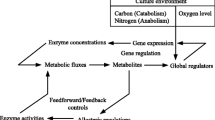Abstract
In this case study, we designed a farnesyl pyrophosphate (FPP) biosynthetic network using hybrid functional Petri net with extension (HFPNe) which is derived from traditional Petri net theory and allows easy modeling with graphical approach of various types of entities in the networks together. Our main objective is to improve the production of FPP in yeast, which is further converted to amorphadiene (AD), a precursor of artemisinin (antimalarial drug). Natively, mevalonate (MEV) pathway is present in yeast. Methyl erythritol phosphate pathways (MEP) are present only in higher plant plastids and eubacteria, but not present in yeast. IPP and DAMP are common isomeric intermediate in these two pathways, which immediately yields FPP. By integrating these two pathways in yeast, we augmented the FPP synthesis approximately two folds higher (431.16 U/pt) than in MEV pathway alone (259.91 U/pt) by using HFPNe technique. Further enhanced FPP levels converted to AD by amorphadiene synthase gene yielding 436.5 U/pt of AD which approximately two folds higher compared to the AD (258.5 U/pt) synthesized by MEV pathway exclusively. Simulation and validation processes performed using these models are reliable with identified biological information and data.









Similar content being viewed by others
Abbreviations
- AD:
-
Amorphadiene
- HFPNe:
-
Hybrid functional Petri net with extension
- MEV:
-
Mevalonate
- MEP:
-
Methylerithritol 4-phosphate
- FPP:
-
Farnesyl pyrophosphate
- IPP:
-
Isopentenyl pyrophosphate
- DMAPP:
-
Dimethylallyl pyrophosphate
- GPP:
-
Geranyl pyrophosphate
References
Dubey, V. S., Bhalla, R., & Luthra, R. (2003). Journal of Biosciences, 28, 637–646.
Michelle, C. Y., Chang, J., & Keasling, D. (2006). Nature Chemical Biology, 2, 674–681.
Kitano, H. (2002). Science, 295, 1662–1664.
Sweetlove, L. J., Last, R. L., & Fernie, A. R. (2003). Plant Physiology, 132, 420–425.
Sweetlove, L. J., & Fernie, A. R. (2005). New Phytologist, 168, 9–24.
Hawari, A. H., & Mohamed-Hussein, Z. A. (2010). BMC Bioinformatics, 11, 83.
Teaching Metabolic Control Analysis and Kinetic Modeling 1999. Available from: www.gepasi.org/TeachingMCA.pdf. Accessed February 14, 2011.
Koch, I., Heiner, M. (2008) Petri nets, 1st edition: Analysis of Biological Networks (Junker, B, H., Schreiber, F) Wiley, Hoboken, NJ, USA.
Gilbert, D., FuB, H., Gu, X., Orton, R., & Robinson, S. (2006). Briefings in Bioinformatics, 7(4), 339–353.
Goryanin, I., Hodgman, T. C., & Selkov, E. (1999). Bioinformatics, 15(9), 749–758.
Rohdich, F., Hecht, S., Gartner, K., & Adam, P. (2002). Proceedings of the National Academy of Science of the U.S.A, 99(3), 1158–1163.
Voynova, N. E., Rios, S. E., & Miziorko, H. M. (2004). Journal of Bacteriology, 186(1), 61–67.
Schulte, A. E., Heijden, V. D. R., & Verpoorte, R. (1999). Phytochemistry, 52(6), 975–983.
Petri, C. A. (1962). Technical Report RADC-TR-65-377, 2. New York, US: Griffiss Air Force Base.
Hiroshi, M., Yukiko, T., Hitoshi, A., & Satoru, M. (2003). In Silico Biology, 3, 389–404.
Ina, K., Bjorn, H. J., & Monika, H. (2005). Bioinformatics, 21, 1219–1226.
Kanehisa, M., Araki, M., Goto, S., Hattori, M., & Yamanishi, Y. (2008). Nucleic Acids Research, 36, D480–D484.
Kanehisa, M., & Goto, S. (2000). Nucleic Acids Research, 28(1), 27–30.
Kanehisa, M., Goto, S., Hattori, M., Aoki-Kinoshita, K. F., & Hirakawa, M. (2006). Nucleic Acids Research, 34, D354–D357.
Chang, A., Scheer, M., Grote, A., & Schomburg, D. (2009). Nucleic Acids Research, 37, D588–D592.
Caspi, R., Foerster, H., Fulcher, C. A., Kaipa, P., Krummenacker, M., & Tissier, C. (2008). Nucleic Acids Research, 36, D623–D631.
Nagasaki, M. (2004), PhD Thesis, University of Tokyo, Japan.
Miyano, S. 2004.25th International Conference on Application and Theory of Petri nets Bologna, Italy. Available from: http://genome.ib.sci.yamaguchi-u.ac.jp/~gon/presentation/ICATPN2004.pdf. Accessed February16, 2011.
Newman, J. D., & Chappel, J. (1999). Critical Reviews in Biochemistry and Molecular Biology, 34, 95–106.
Author information
Authors and Affiliations
Corresponding author
Rights and permissions
About this article
Cite this article
Baadhe, R.R., Mekala, N.K., Palagiri, S.R. et al. Development of Petri Net-Based Dynamic Model for Improved Production of Farnesyl Pyrophosphate by Integrating Mevalonate and Methylerythritol Phosphate Pathways in Yeast. Appl Biochem Biotechnol 167, 1172–1182 (2012). https://doi.org/10.1007/s12010-012-9583-1
Received:
Accepted:
Published:
Issue Date:
DOI: https://doi.org/10.1007/s12010-012-9583-1




